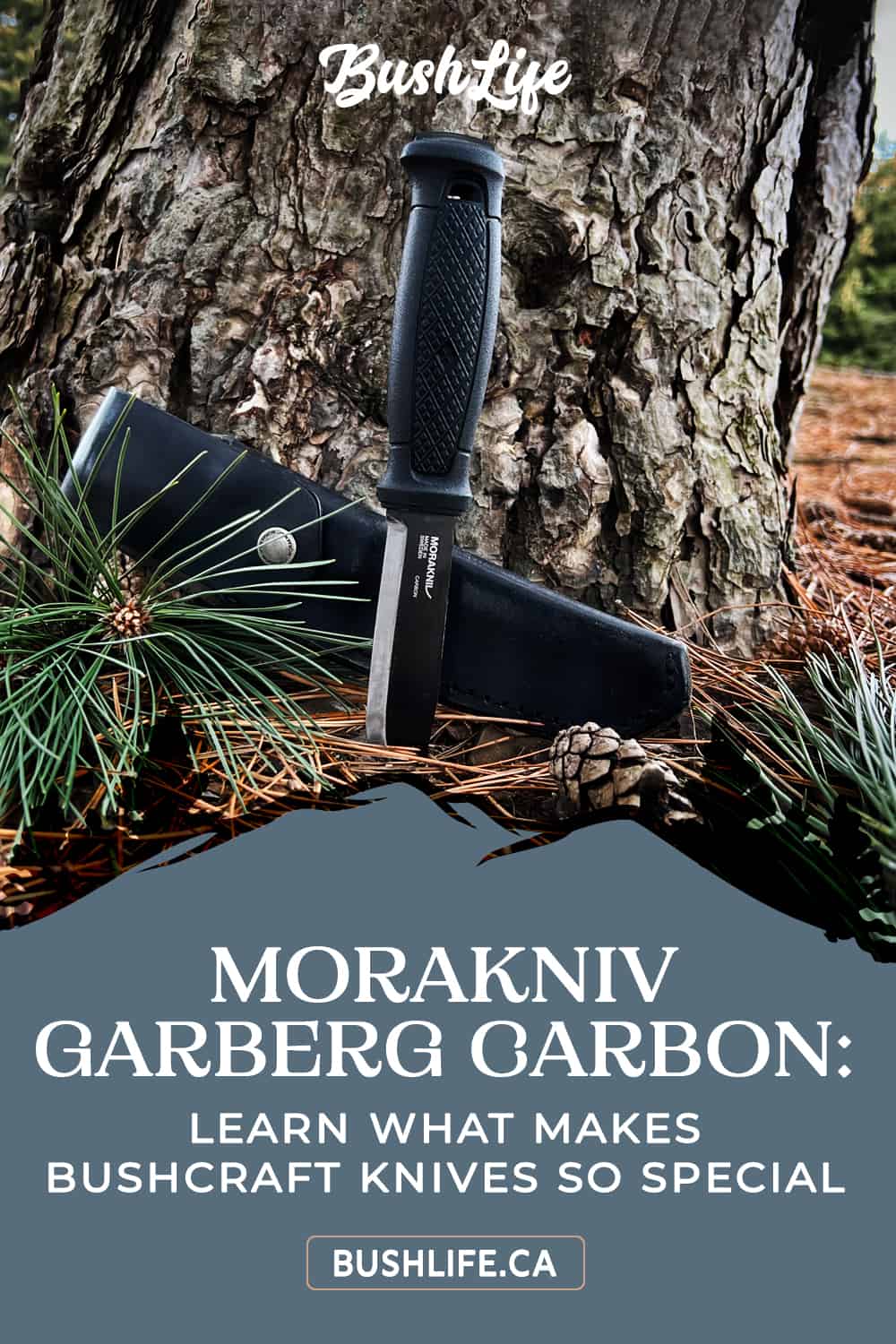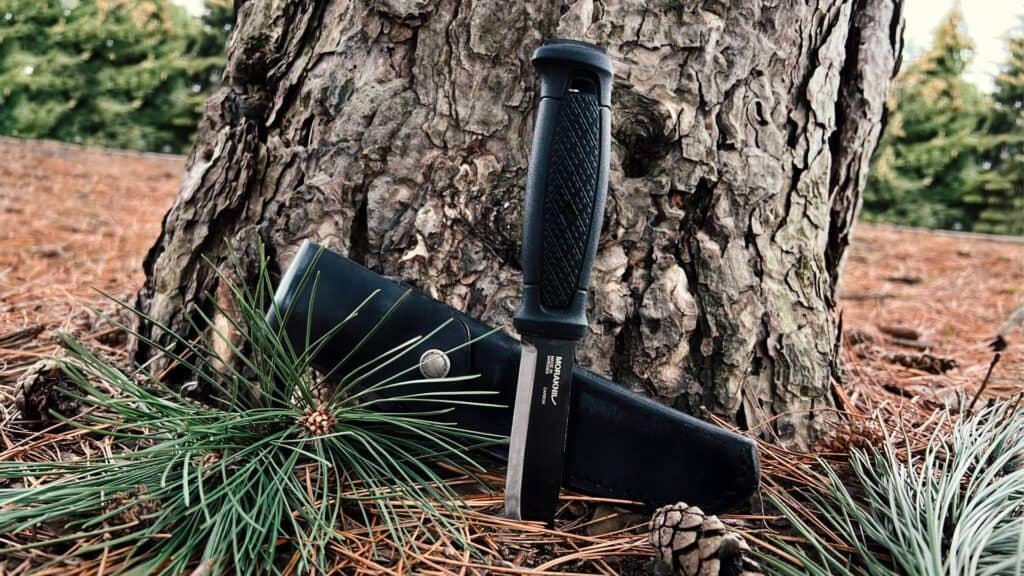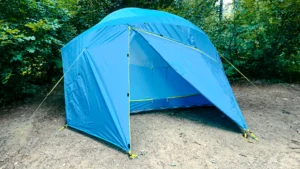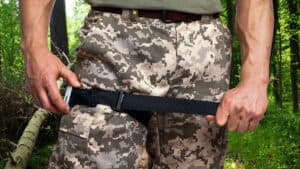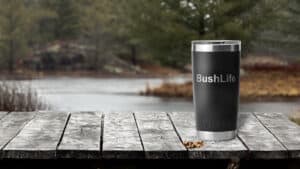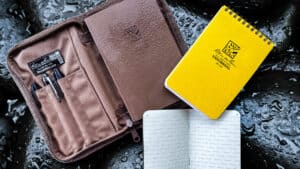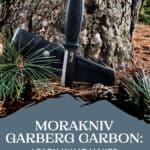Morakniv is the maker (more affectionately known as “Mora”), and Garberg is the model. Since this is BushLife, it’s time to man up that blade and skip the stainless steel. Throughout this Morakniv Garberg Carbon review, you’ll understand why this bushcraft knife is so special.
Discloure: Posts may contain affiliate links. Purchases made through our links result in a small commission to us at no charge to you. We only recommend products that meet our brand standards based on testing and first hand use by our authors.
- So, What is a Knife Really?
- The Bushcraft Knife at Your Service
- Morakniv Garberg Sheath
- Morakniv Garberg Price
- Let’s Go Back to My List For A Second
- Comparisons to the Mora Garberg Carbon Knife
- Final Verdict of the Morakniv Garberg Carbon
- Is There a More Budget Friendly Knife than the Garberg?
- Further Reading: The Total Knife Manual
So, What is a Knife Really?
A knife is a tool that is traced back 2.5 million years! Even the first known folding knife goes back to 500-600 BC. I bet you didn’t know that. Neither did I up until 5 minutes ago.
We are discussing one of the oldest known tools used by humans. While things have changed over the years, the basic principle of a knife is still the same: a sharp edge that can cut things. Well, yes and no. A modern knife can do a lot more than that!
Why do I bring this up – get on with the Mora Garberg review already???!!! We need to put things in context to match the knife to the task(s) at hand to review it properly. If we ask ourselves what we truly need our knife to do in the bush, the list looks something like this:
- Cut vines to make rope
- Cut wood to make shelter
- Chop firewood
- Split firewood (Batoning, I’ll explain below)
- Preparing tinder (Feather sticking, also below)
- Hunting and god help you on this one:)
- Processing food
- Digging and harvesting what we can forage
- Carving containers, utensils, furniture and tools
- And on and on
That’s a lot more than just a sharp edge that cuts things. It also means the discussion is not just about what it’s made of or some fancy specs. It’s about how these specs achieve the items on this list! Now, I hope you see where I am going with this.
Further Reading: Silky BIGBOY: Why A Saw Beats an Axe Every Time
The Bushcraft Knife at Your Service

Now that we know a knife can do several vital things, here comes the bad news: no knife does it all perfectly! A knife with excellent properties for batoning might render it horrible at feather sticking. This is why we have specialty knives for hunting, survival, bushcraft, tactical, etc.
The Morakniv Garberg is, by definition, a bushcraft knife, and bushcraft knives have certain features that make them better at handling “the list” in general. Let’s cover the top attributes of bushcraft knives, and we’ll bring the Morakniv Garberg in as we go.
Best Size for a Bushcraft Knife
A bushcraft knife should not be too big – it should be just right. With big blades, you end up losing finer details. Think of carving a spoon with a machete, while exaggerating the point you see what I mean. The same goes for skinning a harvested animal – a big knife will only get in the way. You don’t want the knife to be too small, as tasks like processing wood will take forever.
The Mora Garberg blade length is 4.29″ or 109 mm long. That’s the general sweet spot for this category of knife. Think of it as the right size for most camp chores.
The Grind
This is a big one! Remember that you are out in the bush, and the loud man with the shiny sharpening truck is nowhere to be seen. After years of laziness, I learned to sharpen my stuff, as should you. But there’s a complication.
Take a minute and look at whatever knife you have on hand. Notice the part where it starts to angle away from the full thickness to where it forms the cutting edge. Plain and simple, it looks like a wedge. Now, look closer and carefully at the knife’s edge, where you will most likely see a second bevel at some point. In other words, you have a wedge in a wedge! While it’s pretty cool, it’s also a LOT harder to sharpen! You need to feel that change in angle if you want to enjoy any sharpening success.
By comparison, the Garberg is a Scandi grind. Ie. that wedge shape goes all the way from the full-thickness part to the actual cutting edge. More technically, it’s a single angle. The Mora Garberg grind angle allows you to grab a sharpening stone and lay that wedge part flat, which is pretty easy to feel now that it’s a larger surface area and sharpen away! It’s foolproof, simple and can sharpened in the bush, even by a beginner.
Tang
The tang is the steel portion of the handle. For a bushcraft knife, you want a full tang. In other words, full tang means the metal sits all the way through the handle and not partly into it. Why is this so important? Strength! You’ll see why when we get to batoning farther below.
The Mora Garberg is a full-tang knife. Put it this way – I wouldn’t be writing about it if it wasn’t. If I’m not mistaken, I believe it is the only full-tang knife made by Morakniv. And if it’s not, it will be one of only a few full-tang models.
Metal is more expensive than plastic, which is precisely why there are so many non-full tang knives out there. On this note, those knives have no place in the bush other than maybe as a fillet knife.
What are Bushcraft Knives Made From?
There are a lot of elements that can go into steel, and each one changes the characteristics.
Iron and carbon are ALWAYS part of the mix. The more carbon, the harder the steel. While this seems generally good for knives, there’s a catch. Harder steel means less toughness. In other words, it’s more likely to chip or break. The beauty of steelmaking is finding the right balance of hardness vs toughness. Amongst a balancing act in other areas.
We all know what stainless steel is. It’s the simple addition of chromium to the mix. The considerable benefit of stainless steel is preventing rust, and it’s probably why it’s the most popular steel for knives. It’s also because people are too lazy to oil and periodically take care of their stuff – so we sell them rust-proof things at the expense of hardness or attributes that are considered vital in the bush.
Let’s get back to carbon steel. Carbon is hard, holds its edge longer, is strong, and is easy to sharpen. It’s also guaranteed to be harder than a Ferro rod. Anything harder than a Ferro rod means it will throw sparks.
The Knife’s Spine
Yes, even this is important. Most knives have a nice bevelled spine, which feels great in the hand. It is also a selling feature for the average Joe Blow who wants a cutting knife.
The Mora Garberg has a 90-degree spine, which does not feel good. The Garberg’s spine is almost sharp, which is intentional. Instead of gliding, it digs right in and throws wicked sparks off a Ferro rod. The bushman, who is not Joe Blow, wants a guaranteed way to make a fire at some point.
As you can imagine, we never want to use our blade for striking a Ferro rod as it would wreck the blade. A bushcraft knife should always parallel as a Ferro rod striker, period. It’s not about being pretty or feeling good – it’s about getting things done!
Morakniv Garberg Sheath
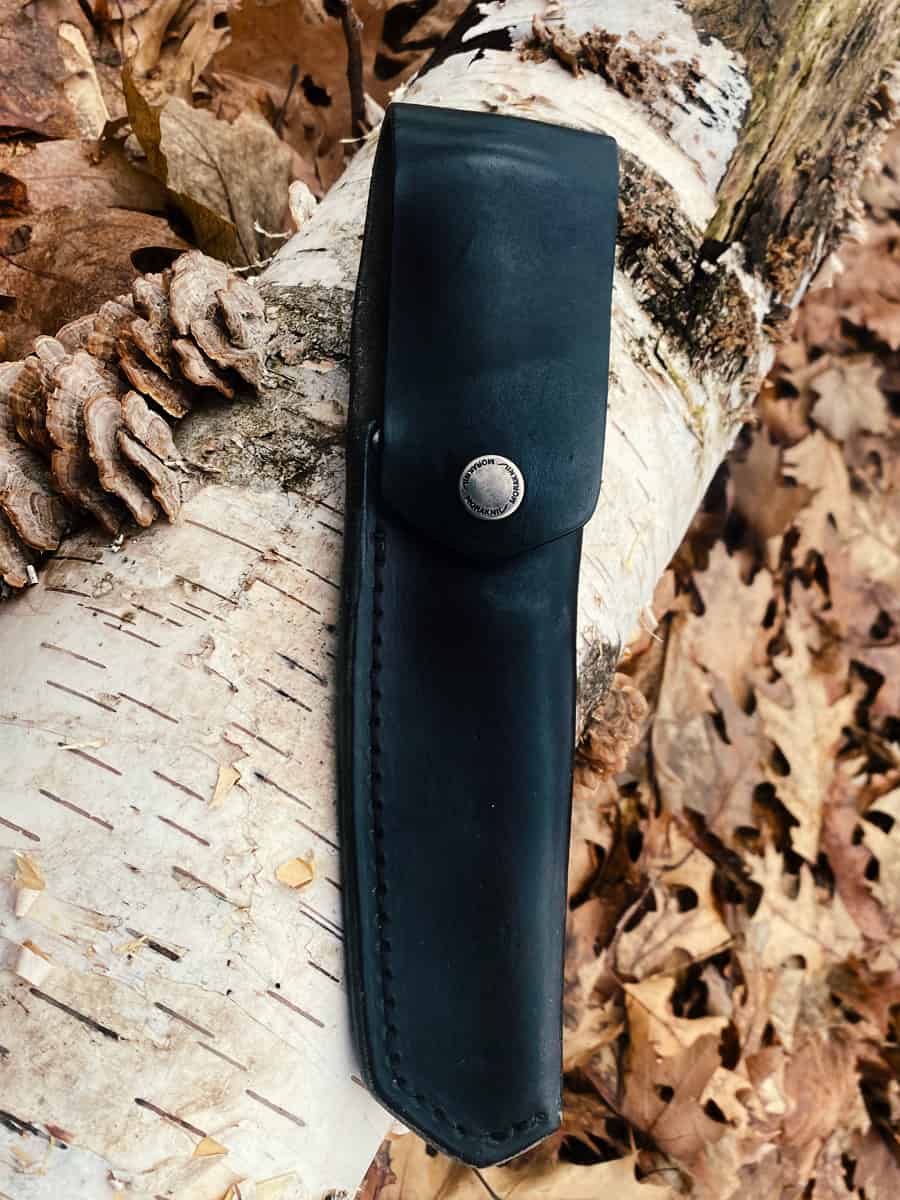
A good sheath is precisely that, and unless you like displaying your knives on a wall, don’t leave this as an afterthought. You have a requirement to safely and conveniently carry your fancy bushcraft knife. The more comfortable the sheath, the more likely it will land on your belt.
The Mora Garberg comes with a few sheath options. The first is the multi-mount sheath, which reminds me of your typical molle style. I don’t want to say tactical, but think of it as a more functional sheath.
Next is Morakniv’s basic polymer sheath with a leather strap. You can opt for the Garberg with Survival Kit, which includes a diamond sharpener and fire steel.
Lastly, my favourite and personal choice is the good old Mora Garberg Carbon leather sheath!
Morakniv Garberg Price
I tend until recently not to talk about price too much in my blog. When it comes to assembling a basic set of survival gear, the price is what it is.
We can splurge on gear that is more important to us and save on others. So long as we understand that good gear doesn’t come cheap, we are on the same page.
Today, however, we have uncertain economic times. It’s times like these when we want to spend $100 – $200 on a knife that does what we NEED, and the Morakniv Garberg Carbon fits the bill. Budget permitting, you may choose to, but you certainly don’t need to spend the $500 and up, which is what it takes to get fancier brands or custom Damascus blades. We also don’t want to fork over $25 – $50 on knives that will keep breaking and cost us more in the long run.
Morakniv is more of a budget knife maker that fabricates phenomenal products at a fair price. Since we need a full tang as a durable bushcraft knife – the Garberg Carbon is on the upper end of Morakniv’s price point. But understand this – most serious knife companies start their prices well above Garberg’s price point. Speaking of price, it makes the Garberg Carbon a gem, which is why I had to make a point of it in my post. The value of this knife is perhaps unparalleled in the market, and it’s a known opinion amongst its loyal followers.
Further Reading: The Budget Bug Out Bag that’s Ready to Rumble
Let’s Go Back to My List For A Second
If you ask anyone who knows their stuff: “If you could only have one item in the bush, what would it be? That answer is always a knife! It’s because of how many different things you can do with it to survive.
While my list of what you can expect your knife to do is self-explanatory, let’s cover some of the more advanced topics:
Batoning With a Knife
Your knife is an axe! This one blew me away when I learnt it years ago, but it’s true. After cutting your firewood to length, you have a problem splitting it. So here’s what you do if you don’t have an axe, and this assumes your blade is a bit longer than the thickness of the wood:
- Flip the wood upright just like you would chop it
- Place your Morakniv Garberg on top
- Make sure the wood is as far back towards the handle as it goes
- Hold the handle in one hand, then whack the blade with a big piece of wood in your other hand
- You’ll see your knife starting to dig in and split the wood
But my knife went in all the way, and the wood didn’t split!?! No problem. Look at your wood and notice the little bit of blade sticking out. Now, whack the front part of the knife that’s sticking out while you keep holding the handle in the back. You’ll see your knife will continue to slide down until that wood splits.
How Does the Morakniv Garberg Baton?
I’ve already mentioned that the Morakniv Garberg is not huge. We don’t want it too big – otherwise, we won’t be able to do finer tasks like carving. With a 4.29″ (109 mm) long blade, you are good to baton 4″ thick wood. You only need a bit of the knife’s blade to stick out on one end to whack. Hence, the reason to place the wood as far back towards the handle as possible.
The Garberg Carbon is super strong and full-tang. I’ve batoned many a log without the worry. In fact, it never crosses my mind. The blade is 3.2 mm thick, which is plenty for strength and thickness in terms of acting as a splitting wedge.
How To Baton Video
The video below is from Dutch Bushcraft Knives. I love these guys! They’re a bit crazy, but they have a fantastic channel all about knives. The video will show you how to baton the proper way. While this video is not about the Garberg, don’t worry, the technique is the same. The video will perfectly supplement my instructions above.
Batoning Bigger Pieces of Wood
Here’s another YouTube video. This one is from Survival Lilly. She will demonstrate how to baton a larger piece of wood. In other words, how to split wood that is wider than the length of your blade. Although I don’t recommend batoning pieces this size as it’s easier to find smaller pieces. There may, however, be a situation where you have no choice.
What is Feather Sticking
Feather sticking is the simple process of taking your knife and shaving thin curls down a piece of wood. You end up with multiple curls, which will light effortlessly, even with a ferro rod. The beauty of this begins to shine during wet times.
When everything is soaking wet, look for dead-standing wood, meaning something up and off the ground. Deadwood will be nice and dry inside. When you feather stick, you expose the drier inner parts of the wood, which aids in getting a fire going during the wet times.
The upper video in this post will show you how to feather stick. I’ve seen many a DBK knife review as they test each blade to see how it performs in various tasks. Feather sticking always being one of them. It’s a great skill to learn if you intend to spend time in the bush.
Since this is a Morakniv Garberg review, I should mention that these knives come sharp. They are good at staying sharp and easy to sharpen if that ever changes. The Garberg has the right amount of bite to easily shave curls off wood without digging in too much.
Comparisons to the Mora Garberg Carbon Knife
The Garberg Carbon is the go-to knife for countless bushcrafters and outdoor enthusiasts. I have several great knives, but honestly, they stay at home. My first decent knife was a Ka-Bar USMC. It’s known as an epic blade, but I find feather-sticking hard with it and would never consider finer work as it’s too big. I also dropped a pretty penny on a Buck Open Season Skinner. Once again, the Buck is a great knife if you’re only skinning animals. I wouldn’t baton with it as it’s too small.
It’s not hard to spend thousands of dollars while searching for that perfect knife. But it’s just as easy to be disappointed over and over again. If the knife doesn’t match the job, it doesn’t matter how shiny or cool it is, or the fancy specs because it’s irrelevant. We often confuse what we want versus what we need, and hopefully, I can spare you that aggravation if you are serious about going to the bush.
Final Verdict of the Morakniv Garberg Carbon
Morakniv is a good brand, making the Morakniv Garberg Carbon a fantastic addition to your outdoor gear or as an edc. It’s a knife that will not disappoint.
The experts turn to the Morakniv Garberg Carbon when heading into the backcountry. Its shape, specs and features make it the ideal companion to a survival situation or a day in the woods. That’s my Morakniv Garberg knife in every photo you see, and I certainly wouldn’t stand behind this product if I didn’t know firsthand how good it really is.
Just an FYI, Morakniv has added a black coating to their Garberg Carbon, now known as the Morakniv Garberg Blackblade. The black coating aids in rust prevention.
Further Reading: Backpack Survival Gear: Secrets of the Ultimate Bug Out Bag!
Is There a More Budget Friendly Knife than the Garberg?
Absolutely: The Morakniv Companion!

The big knife brands such as Fallkniven, Bark River, Benchmade, Esee, and so on will charge several hundred dollars for a knife. These are excellent knives, but the Garberg can compete with them at around the $150 mark. However, even $150 for a knife may seem steep in these economic times.
A budget-friendly alternative to the Mora Garberg is the Morakniv Companion. The price of the Companion is under $30, and for this price, it’s one serious knife! That comes from experience, as I have one myself.
The Morakniv Companion comes in stainless (pictured above) or carbon (preferred) steel, and it still sports Morakniv’s lifetime warranty. In Mora style, it also arrives razor sharp – this too is from experience, as the first thing I did with it was effortlessly shave a patch of hair off my arm! That makes it an insane value.
Morakniv Garberg vs Companion – Can it Baton?
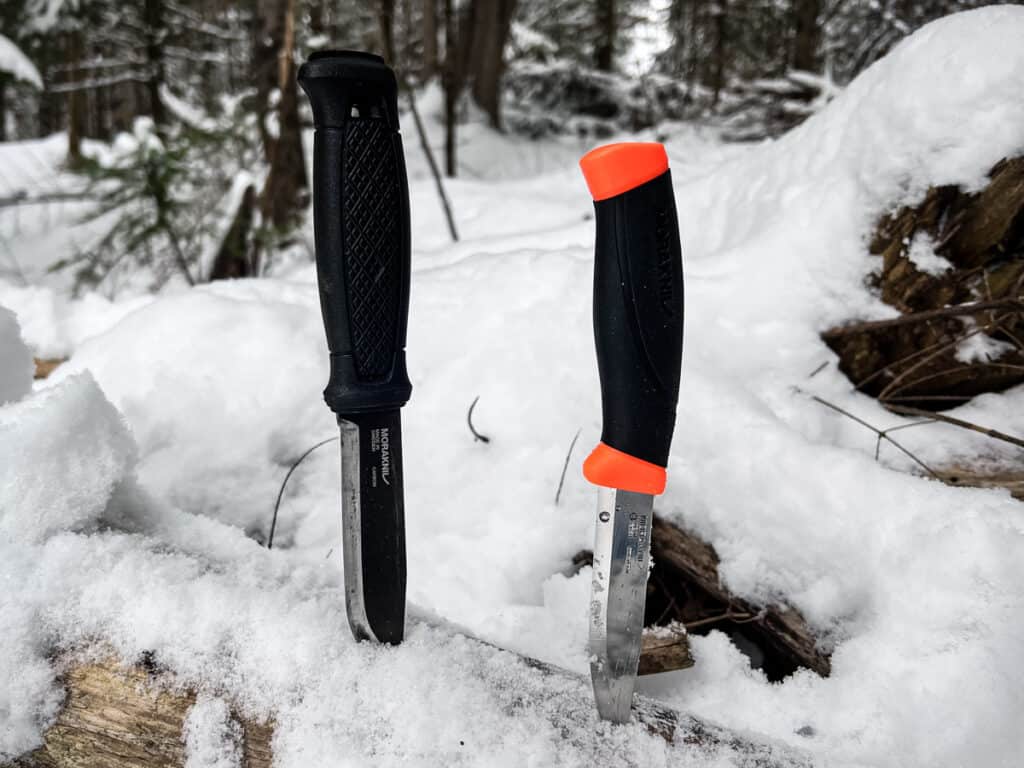
We already know that the Morakniv Garberg can baton easily. The Companion has a 3/4 tang, meaning that the tang comes up three-quarters of the knife’s handle. While not full tang, it’s quite a bit. The Mora Companion blade, however, is thinner at 2 mm than that of the Garberg’s at 3.2. It can handle some light batoning, but keep it light. That would cover tasks such as processing smaller softwoods for kindling.
Can the Morakniv Companion be Used With a Ferro Rod?
Yes. Morakniv says no since the knife isn’t “polished”, but there is a solution. All you need to do is file down the back of the knife until you get that 90-degree spine, just like the Garberg Carbon! It’s that defined edge in carbon steel, which allows you to throw sparks with fire steel. If you are willing to put in a little work, you’ll get your results here even on the tightest budget.
While the Morakniv Companion will never be a Garberg, it has several similar attributes that suit that bushcraft/survival niche just fine. And yes, many people use it as their edc and swear by it after years of abuse! It’s worth being considered as an ultra-budget-friendly alternative to the Garberg.
Further Reading: The Total Knife Manual
I want to pass along a fantastic book by Field & Stream. The entire series of books is well-written, and it’s worth noting that every page has photos.
This book covers knife design, types, multi-tools, custom knives and knife care. It also covers what knives to use for hunting, fishing, wild kitchen, camping and survival. If that’s not enough, it gives you the ins and outs of axes, hatchets and saws!
Not only have I read this book, I refer back to it religiously. If you love knives or enjoyed this post, The Total Knife Manual is definitely for you. Grab one while you can!
Thank you for reading my Morakniv Garberg Carbon Knife Review. Please like and follow or sign up for our newsletter for more honest and unbiased reviews.
Bookmark this post on Pinterest for future reference!
